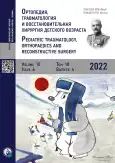Multistage surgical treatment of early-onset scoliosis in patients with Ehlers-Danlos syndrome: A series of observations
- Authors: Mikhaylovskiy M.V.1, Suzdalov V.A.1
-
Affiliations:
- Novosibirsk Research Institute of Traumatology & Orthopedics
- Issue: Vol 10, No 4 (2022)
- Pages: 449-457
- Section: Clinical cases
- URL: https://journal-vniispk.ru/turner/article/view/264659
- DOI: https://doi.org/10.17816/PTORS111126
- ID: 264659
Cite item
Abstract
BACKGROUND: Ehlers–Danlos syndrome (EDS) is a group of hereditary pathological conditions caused by various disorders of collagen biosynthesis. The study analyzed the results of multistage surgical treatment of early scoliosis in patients with severe spinal deformities due to EDS. No similar observations have been found in the literature.
CLINICAL CASES: Four patients with a verified diagnosis of EDS and progressive spinal deformities were subjected to multistage surgical treatment using the VEPTRII instrumentation, which included periodic distractions and “final” spinal fusion with segmental instrumentation. Stage-by-stage surgical treatment was initiated from the age of 3 to 6 years. In 3 of 4 cases, the kyphotic component prevailed over the scoliotic one (86°–140° vs. 21°–110°). The number of staged distractions ranged from 6 to 10. The age of the final stage (correction and dorsal fusion) was 9–14 years (surgery was performed in three of four cases). The primary correction was 30°–56°, the loss of correction before the final stage was 14°–35°, and the correction during the final stage was 22°–40°. A significant correction of the frontal and sagittal imbalances of the spine was noted. Blood loss during the “final” fusion was 540–750 mL, and the operation time was 310–350 min. Ten complications occurred, of which 9 were associated with implants and disappeared during staged distractions. No neurological and vascular complications occurred.
DISCUSSION: Scoliosis occurring in the first decade of life in patients with EDS is characterized by early-onset, rapid progression, and tendency to form a significant kyphotic component of spinal deformity.
CONCLUSIONS: Multistage treatment of early scoliosis in patients with EDS using VEPTRII tools allows for obtaining quite satisfactory results and has not severe complications. The “final” fusion gives a significant corrective effect; however, new research and accumulation of data are needed to optimize the treatment process.
Full Text
##article.viewOnOriginalSite##About the authors
Mikhail V. Mikhaylovskiy
Novosibirsk Research Institute of Traumatology & Orthopedics
Author for correspondence.
Email: MMihailovsky@niito.ru
ORCID iD: 0000-0002-4847-100X
SPIN-code: 5828-8306
Scopus Author ID: 57028305800
ResearcherId: C-5483-2017
MD, PhD, Dr. Sci. (Med.), Professor
Russian Federation, NovosibirskVasiliy A. Suzdalov
Novosibirsk Research Institute of Traumatology & Orthopedics
Email: vsuzdalov@mail.ru
ORCID iD: 0000-0003-2581-1638
SPIN-code: 5287-6560
Scopus Author ID: 57203745429
ResearcherId: AAP-2266-2020
MD, PhD, Cand. Sci. (Med.)
Russian Federation, NovosibirskReferences
- Van Meekeren J. On the extraordinary dilatability of the skin // Observations Mediconchirurgicae. Amsterdam; 1682. (In Esp.)
- Tschernogorow A. Cutis Laxa (Presentation at first meeting of Moscow Dermatologic and Venerologic Society, November 13, 1891). Monthly Bulletins of Practical Dermatologic. 1892;14:76.
- Ehlers E. Cutis laxa, tendency to haemorrhages in the skin, loosening of several articulations. Dermatological Journal. 1901;8:173–174. (In Deu.)
- Danlos H. A case of cutis laxa with tumors by chronic contusion of the elbows and knees (pseudo-diabetic juvenile xanthoma of Messrs. Hallopeau and Mace Lepinay). Bulletin of the French Society of Dermatology and Syphiligraphy.1908;19:70. (In Deu.)
- El-Shaker M, Watts H. Acute brachial plexus neuropathy secondary to halo-gravity traction in a patient with Ehlers-Danlos syndrome. Spine. 1991;16:385–386. doi: 10.1097/00007632-199103000-00029
- McMaster M. Spinal deformity in Ehlers-Danlos syndrome. five patients treated by spinal fusion. J Bone Jt Surg. 1994;76(5):773–777.
- Akpinar S, Gogus A, Talu U, et al. Surgical management of the spinal deformity in Ehlers-Danlos syndrome type VI. Eur Spine J. 2003;12:135–140. doi: 10.1007/s00586-002-0507-6
- Debnath U, Sharma H, Roberts D, et al. Coeliac axis thrombosis after surgical correction of spinal deformity in type VI Ehlers-Danlos syndrome. Spine. 2007;32(18):E528–E531. doi: 10.1097/BRS.0b013e31813162b3
- Yang L, Rui G, Xuhui Zh, et al. Posterior spinal fusion for scoliosis in Ehlers-Danlos syndrome, kyphoscoliosis type. Oethopedics. 2011;34(6):E228–E232. doi: 10.3928/01477447-20110427-28
- Asher M, Lai S, Burton D, et al. Maintenance of trunk deformity correction following posterior instrumentation and arthrodesis for idiopathic scoliosis. Spine. 2004;29(16):1782–1786. doi: 10.1097/01.brs.0000134568.45154.34
- Bridwell K, Hanson D, Rhee J, et al. Correction of thoracic adolescent idiopathic scoliosis with segmental hooks, rods and Wisconsin wires posteriorly: it’s had and obsolete, correct? Spine. 2002;27(18):2059–2066. doi: 10.1097/00007632-200209150-00018
- Sankar W, Skaggs D, Yazici M, et al. Lengthening of dual growing rods and the law of diminishing returns. Spine. 2011;36:806–809. doi: 10.1097/BRS.0b013e318214d78f
- Jain A, Sponseller P, Flynn J, et al. Avoidance of ‘final’ surgical fusion after growing-rod treatment for early onset scoliosis. J Bone Jt Surg. 2016;98:1073–1078. doi: 10.2106/JBJS.15.01241
- Yang J, Sponseller P, Yazici M, et al. Vascular complications from anterior spine surgery in three patients with Ehlers-Danlos syndrome. Spine. 2009;34(4):E153–E157. doi: 10.1097/BRS.0b013e31818d58da
Supplementary files









